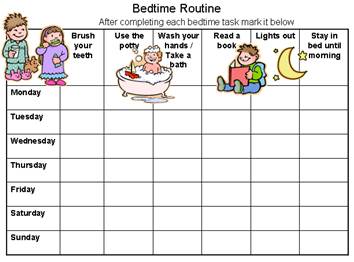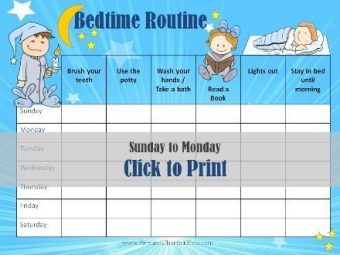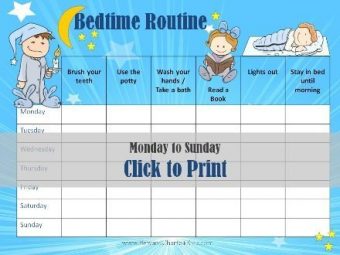Bedtime Routine Chart
Bedtime Routine Chart

There are two versions of this chart:
1) One bedtime routine chart with the term “Use the potty.”
2) Another bedtime routine chart with the term “Use the toilet.”
Customized Bedtime Chart
Sample Toddler Bedtime Routine
Sticking to a bedtime routine is one of the best ways to get your children to go to bed when the time comes. Keeping a bedtime routine chart will help you stick to the bedtime routine and even make it fun for your kids. Make sure that your child knows exactly what to expect and repeat the bedtime routine every day. Give them enough notice before you start.
A toddler bedtime routine helps create a calm and soothing environment to prepare your child for sleep. Here’s a sample toddler bedtime routine:
- Dinner: Have a balanced and nutritious dinner at a reasonable hour, avoiding heavy or sugary foods close to bedtime.
- Playtime: Engage in calming activities an hour before bedtime, such as reading books, building with blocks, or doing puzzles. Avoid stimulating activities or screens during this time.
- Bath: A warm and soothing bath can help relax your toddler. Use gentle baby-friendly products and make it a pleasant experience.
- Pajamas: Put on comfortable pajamas, ensuring your toddler is neither too hot nor too cold.
- Brush Teeth: Establish good dental hygiene by gently brushing your toddler’s teeth.
- Potty Time: Encourage your toddler to use the potty or have a diaper change before bedtime to ensure comfort during the night.
- Bedtime Story: Choose a calming and soothing book to read aloud. This can be a cherished bonding time.
- Lullaby or Calm Music: Play soft lullabies or calming music in the background to create a serene atmosphere.
- Cuddle Time: Spend a few minutes cuddling, talking about the day, and offering reassurance.

A consistent bedtime routine is a valuable and essential aspect of a child’s daily life. It goes beyond merely preparing them for a good night’s sleep; it plays a significant role in their overall physical, emotional, and cognitive development.
We offer a standard bedtime routine chart with six tasks before bedtime. You can also use our online chart maker to make your own bedtime chart with your specific routine. This will also enable you to use the terminology that your child is used to, whether it is “go potty,” “go to the toilet,” or whatever term you want to use.
A bedtime routine can help both parents and children make going to sleep a pleasant experience, according to The American Occupational Therapy Association.
Tips
- Nightlight: If your child prefers it, provide a nightlight or a soft, comforting object like a stuffed animal.
- Goodnight Routine: Say goodnight to specific items or people in the room, creating a reassuring pattern.
- Lights Out: Turn off the main lights, leaving only the nightlight if necessary.
- Hugs and Kisses: Give goodnight hugs and kisses, emphasizing that you’ll be nearby if needed.
- Quiet Time: Encourage your toddler to relax and close their eyes, preparing for sleep.
- Bedtime Routine Consistency: Try to maintain a consistent schedule, doing the same activities in the same order each night. This helps signal to your child that it’s time for sleep.
Remember, every child is unique, and you might need to adjust this routine to suit your toddler’s preferences and needs. The key is to create a peaceful and comforting environment that helps your little one wind down and transition into a restful night’s sleep.
How to create an effective bedtime routine for kids
Creating an effective bedtime routine for kids involves a combination of consistency, calming activities, and a soothing environment. Here’s a step-by-step guide to help you establish a successful bedtime routine:
- Set a Consistent Bedtime: Choose a bedtime that allows your child to get enough sleep based on their age. Stick to this bedtime every night, even on weekends, to regulate their internal body clock.
- Establish a Wind-Down Period: About 30 to 60 minutes before bedtime, start winding down with calming activities. Avoid stimulating activities like screen time, video games, or rough play during this period.
- Quiet Activities: Engage in quiet and relaxing activities with your child, such as reading a book together, drawing, or listening to calming music. This signals to their brain that it’s time to prepare for sleep.
- Limit Sugary Snacks and Caffeine: Avoid giving your child sugary snacks or caffeinated beverages close to bedtime, as these can disrupt sleep patterns.
- Create a Peaceful Bedroom Environment: Ensure the bedroom is conducive to sleep. Keep the room dark, cool, and quiet. Use blackout curtains to block out light and consider using white noise machines to mask disruptive sounds.
- Make their bedroom a place that they want to go to: Make their bedroom a place that they enjoy going to. If they don’t have their own bedroom, then try to designate an area just for them. Let them help arrange the furniture and decorate their room or their section of the room. You want this to be a special place that they enjoy going to. Make it clear to family members that this room or this area belongs to them. If others want to enter, then they should only do so with permission. If they are afraid of the dark, then make sure you have suitable lighting that you can leave on all night. Either use a nightlight or leave a light on outside his room. If they are scared of the dark, then it makes no sense for the room to be dark at night. If you have space, then keep toys in a separate room so that the bedroom is a place for sleeping and not playing. It will also help keep the bedroom tidy and the mess in the playroom. Their bedroom will be a place to go and sleep, and it will be clear they are not going to their room to play but to sleep. Teach them how to make their beds and tidy their rooms. You might want to use our free printable chore charts for this.
- Develop a Bedtime Ritual: Establish a consistent sequence of activities that your child performs before going to bed. This can include brushing teeth, washing face, using the bathroom, and putting on pajamas.
- Comforting Objects: If your child has a special comfort object like a stuffed toy or blanket, allow them to have it at bedtime for added security and comfort.
- Positive Affirmations: Encourage your child to share positive thoughts or talk about their day before going to sleep. Offer praise and encouragement for their accomplishments.
- Consistent Sleep Environment: Whenever possible, maintain the same sleep environment for your child, whether at home or when traveling. Familiarity helps them feel secure and aids in falling asleep.
- Read a book together every night: Reading to your child is very important and an integral part of the bedtime routine. Read the story or book in bed. This gives them something to look forward to in bed and signals that the day is officially over. They must understand that there will be no more TV or games and they cannot leave their bed. It must be clear that leaving their bed is NOT an option. If they need something important, then they can call you. They need to know that you are there for them if they have a real problem. Knowing that you will come if they really need you will make them feel safe. Of course, you will need to ensure that they do not take advantage of this.
- Set a “Lights Out” Time: Determine when it’s time to turn off the lights and go to sleep. A nightlight can be used if your child feels uneasy in complete darkness.
- Lead by Example: As a parent or caregiver, follow a consistent bedtime routine as well. Your actions will demonstrate the importance of a regular sleep schedule.
- Be Patient and Reassuring: If your child has difficulty falling asleep or feels anxious, be patient and offer reassurance. Avoid showing frustration or making bedtime stressful.
- Avoid Big Emotional Discussions: Save important or emotional conversations for daytime hours. Bedtime is a time for relaxation and winding down, not for intense discussions.
- Celebrate Success: Praise your child for following their bedtime routine. Positive reinforcement will motivate them to continue with the routine.
Don’t use their bedroom as a punishment room. If you send them to their room for misbehaving, then it will become a place that they don’t want to go to.
Creating an effective bedtime routine takes time and patience. Be flexible and willing to adjust the routine based on your child’s needs. By consistently following these steps, you can establish a soothing bedtime routine that will help your child fall asleep more easily, get adequate rest, and wake up refreshed and ready for the day ahead.
The Importance of a Bedtime Routine for Kids
Here are some key reasons why a bedtime routine is crucial for kids:
- Better Sleep Quality: A regular bedtime routine helps regulate a child’s internal clock and signals their body that it’s time to wind down. This leads to improved sleep quality, as they are more likely to fall asleep faster and experience fewer sleep disruptions during the night.
- Emotional Regulation: Following a predictable bedtime routine can help children feel secure and comforted. It provides a sense of stability and control over their environment, promoting emotional well-being and reducing anxiety or bedtime-related fears.
- Enhanced Behavior: Well-rested children tend to exhibit better behavior and have improved attention spans during the day. A regular bedtime routine helps establish healthy sleep patterns, leading to improved behavior and overall mood.
- Family Bonding: Bedtime routines present an excellent opportunity for parents and caregivers to spend quality time with their children. Engaging in calming activities together, such as reading books or having quiet conversations, fosters a strong parent-child bond.
- Establishing Discipline and Responsibility: Consistently following a bedtime routine teaches children about the importance of structure and responsibility. It empowers them to take ownership of their nightly preparations, such as brushing teeth or getting ready for bed independently.
In conclusion, a bedtime routine is much more than just a set of steps to prepare for sleep; it is a fundamental building block for a child’s well-being and development. Consistency, comfort, and bonding during these nighttime rituals are essential for nurturing healthy sleep habits and promoting positive physical and emotional outcomes. By prioritizing and maintaining a bedtime routine, parents and caregivers provide their children with the foundation they need to thrive both during sleep and throughout their waking hours.
How can I stop my child from stalling at bedtime?
Kids often stall at bedtime for various reasons, such as seeking attention, delaying sleep, or experiencing separation anxiety. Establishing a consistent bedtime routine and setting clear boundaries can help reduce stalling. Here are some strategies to consider:
- Establish a Consistent Routine: Create a predictable bedtime routine that includes calming activities, such as a bath, bedtime story, and cuddle time. Consistency helps signal to your toddler that it’s time to wind down and sleep.
- Set Clear Expectations: Communicate to your toddler what’s expected during the bedtime routine. Let them know that after certain activities, it’s time to sleep. Use gentle reminders to help them transition.
- Create a Relaxing Environment: Make the bedroom a comfortable and soothing space. Use soft lighting, play calming music or white noise, and have a favorite stuffed animal or blanket for comfort.
- Limit Exciting Activities: Avoid stimulating activities, loud play, or screen time close to bedtime. Engage in calming activities that help your toddler relax.
- Use a Timer: Set a timer for each part of the bedtime routine, so your toddler knows when each activity will end. This helps manage expectations and reduces stalling.
- Offer Choices: Give your toddler limited choices, such as selecting a bedtime story or picking out pajamas. This gives them a sense of control while staying within the bedtime routine.
- Address Fears: If your toddler stalls due to fears or separation anxiety, acknowledge their feelings and offer comfort. Reassure them that you’ll be nearby and check on them periodically.
- Be Patient: It’s normal for toddlers to test boundaries, especially at bedtime. Stay patient, but also firm in maintaining the bedtime routine.
- Positive Reinforcement: Offer praise and positive attention when your toddler follows the bedtime routine without stalling. A small reward system, such as a sticker chart for each successful bedtime, can be motivating.
- Stick to the Plan: Be consistent with the bedtime routine and boundaries you set. Consistency is key to helping your toddler understand the expectations.
- Transition Items: If your toddler stalls due to attachment to certain items (e.g., a specific toy), allow them to keep one comforting item in bed but set limits on additional items.
Every child is unique, and it may take time for your toddler to adjust to the new routine. Be patient, stay calm, and provide loving reassurance while gently guiding them toward a smoother bedtime routine.
See 10 ways to get your child to sleep in her bed
Check out our morning routine charts as well!





Thank you for your suggestion.
As a mom of a 5 yr old who does not want to go to bed… this was the perfect find! Thank You!
This completely worked! Thank you!
Thank you truly healthful and easy to create!